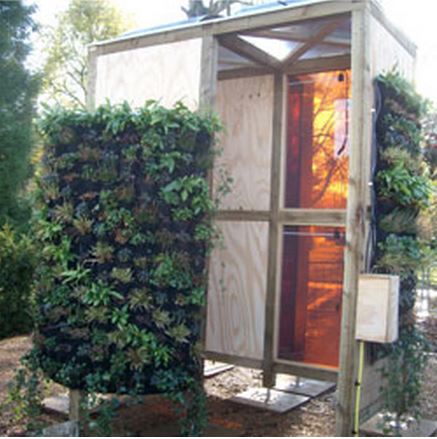Scientists at the University of Cambridge, eco-companies, and a firm of architects have developed a “green bus shelter” that could eventually generate enough electricity to become completely power autonomous.
The researchers have used green wall technology and semi-transparent solar panels to general electricity from a renewable source of energy 24 hours a day – even when it is dark.
The ongoing living experiment is hosted by Cambridge University Botanic Gardens and is open to the general public. It is incorporated in a distinct wooden hub, designed to look like a bus shelter by architects MCMM.

Generates electricity night and day. (Image: University of Cambridge)
Wall specialists Scotscape have created eight vertical green walls, while Polysar has provided the four semi-transparent solar panels plus two fixed ones.
Using processes in nature to generate electricity
The vertical green walls in the hub have been specially adapted to harvest electrons that are naturally produced as a by-product of photosynthesis and metabolic activity, which are then converted into electrical current.
The project is the brainchild of Dr. Paolo Bombelli and Professor Christopher Howe, both from the Department of Biochemistry. They had previously created a device to power a radio using electrical current generated by moss.
The thin-film solar panels mainly use the green and blue radiation of the solar spectrum to convert light into electricity.
Plants grow behind the solar glass. They “share the light” by utilizing the red spectrum radiation required for photosynthesis, while avoiding UV light’s scorching effect.
The plants generate electricity resulting from photosynthesis and metabolic activity, both during the day and night time.
“Ideally you can have the solar panels generating during the day, and the biological system at night. To address the world’s energy needs, we need a portfolio of many different technologies, and it’s even better if these technologies can operate in synergy.”
Researchers testing different combinations
The hub’s structure allows scientists to try out different combinations of the photovoltaic and biological systems. In its north east aspect, plants get light directly, without being exposed to excessive direct sunlight.
On the south west aspect, a green wall panel has been installed behind a semi-transparent solar panel so that the effect on the plants and their capacity to generate electricity can be monitored.
Next to that, also on the south west orientation, a single solar panel stands alone, and two more panels are mounted on the roof.
Joanna Slota-Newson, who works at Polysolar, said:
“The combination of horticulture with renewable energy production constitutes a powerful solution to food and resource shortages on an increasingly populated planet.”
“We build our semi-transparent solar panels into greenhouses, producing electrical energy from the sun which can in turn be used to power irrigation pumps or artificial lighting, while offering a controlled environment to improve agricultural yields. In this collaboration with Cambridge University, the public can experience the plants’ healthy growth behind Polysolar panels.”
The hub’s green wall panels, made from a synthetic material, have pockets with a litre of soil and several plants in each one.
The pockets have a lining of carbon fibre on the back, which acts as an anode to receive electrons from the metabolism of the bacteria and plants in the soil. In the front there is a carbon/catalyst plate, which acts as a cathode.
Getting electricity using photosynthesis
During a plant’s photosynthesis, solar energy is used to convert CO2 into organic compounds that the plant needs for growth. Some of the compounds – lipids, proteins and carbohydrates – are leached into the soil where bacteria break them down, which in turn release by-products, electrons among them, as part of the process.
When electrons, which have a negative charge, are generated, protons (with a positive charge) are also created.
When the cathode and anode are connected to each other by a wire, which acts as an external circuit, the negative charges migrate between the two electrodes. Simultaneously, the positive charges migrate from the anodic region to the cathode through the soil (the wet system).
The cathode contains a catalyst that enables the protons, electrons and atmospheric oxygen to recombine to form water, thus completing the circuit and allowing electricity to be generated in the external circuit.
Electricity from biological and physical elements
The researchers wrote:
“The P2P hub therfore generates electrical current from the combination of biological and physical elements. Each element of the hub is monitored separately, and members of the public can track the findings in real time, at a dedicated website and on a computer embedded in the hub itself.”
Senior Architect and Director of MCMM Architettura, Margherita Cesca, who designed the hub, said she is pleased with the interest it has so far generated.
Mr. Cesca said:
“This prototype is intended to inspire the imagination, and encourage people to consider what could be achieved with these pioneering technologies. The challenging design incorporates and showcases green wall and solar panels as well as glass, creating an interesting element which sits beautifully within Cambridge University Botanic Garden.”
Dr. Bombelli added:
“The long-term aim of the P2P solar hub research is to develop a range of self-powered sustainable buildings for multi-purpose use all over the world, from bus stops to refugee shelters.”
